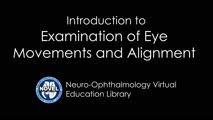Collection of materials relating to neuro-ophthalmology as part of the Neuro-Ophthalmology Virtual Education Library.
NOVEL: https://novel.utah.edu/
TO
- NOVEL981
Filters: Collection: "ehsl_novel_novel"
| Title | Creator | Description | Subject | ||
|---|---|---|---|---|---|
| 376 |
 |
Slit Lamp Binocular | Devin D. Mackay, MD; Valérie Biousse, MD | Description of the slit lamp binocular examination. | Slit Lamp Binocular |
| 377 |
 |
Indirect Ophthalmoscope | Devin D. Mackay, MD; Valérie Biousse, MD | Explanation of using the indirect ophthalmoscope in examinations. | Indirect Ophthalmoscope |
| 378 |
 |
Indirect Ophthalmoscopy | Jonathan Micieli, MD, CM | Demonstration of using the indirect ophthalmoscope in examinations. | Indirect Ophthalmoscopy |
| 379 |
 |
Panoptic Ophthalmoscope | Amrita D. Vuppala, MD | Demonstration of using the panoptic ophthalmoscope in examinations. | Panoptic Ophthalmoscope |
| 380 |
 |
Magnetic Resonance Imaging (MRI) | Devin D. Mackay, MD | Explanation of using magnetic resonance imaging (MRI) in examinations. | Magnetic Resonance Imaging (MRI) |
| 381 |
 |
OJS Reviewer Tutorial | A. Roylance | Tutorial for testing new OJS system for reviews of NOVEL submissions. | OJS Review System |
| 382 |
 |
OJS Author Tutorial | A. Roylance | Tutorial for testing new OJS system for reviews of NOVEL submissions. | OJS Review System |
| 383 |
 |
Video Introduction to the NExT Curriculum Collection | Sachin Kedar, MD, Editor-in-Chief | Introduction to the NANOS NExT ebook. Explains the purpose of the collection. Covers the sections of the outline, and describes the learning levels and objectives. | NANOS Examination Techniques |
| 384 |
 |
Pupils Light Near Dissociation | Karl C. Golnik, MD | This narrated presentations describes light near dissociation. | Pupil; Light Near Dissociation |
| 385 |
 |
Examination of Eye Movements and Alignment | Jason H. Peragallo, MD | Introduction to the examination of eye movements and alignment. | Eye Movements; Alignment |
| 386 |
 |
Orbit Evaluation | Allison Crum, MD | Presentation covering the evaluation of the orbit. This includes external examination of facial symmetry and skin. Also covered is the evaluation of the orbit. | Orbit |
| 387 |
 |
Selective Saccadic Palsy After Cardiac Surgery | Nilan D. Schnure, MD; Ali G. Hamedani, MD, MHS; Grant T. Liu, MD | A unique gaze palsy selectively affecting saccades while sparing smooth pursuit, vergence, and vestibular reflex eye movements has been described following uncomplicated cardiac (and especially ascending aortic) surgery . This 69 year-old man reported persistent visual complaints immediately after a... | Saccade; Saccadic Palsy; Cardiac Surgery |
| 388 |
 |
Cranial Nerves: Neuroanatomy Video Lab - Brain Dissections | Suzanne S. Stensaas, PhD | The approach is to learn to associate the cranial nerves with their brainstem level and blood supply. Emphasis is given to the midbrain (3, 4), pons (5, 6, 7, 8), medulla (9, 10, 11, 12) and their most important functions. | Cranial Nerves; Brain; Dissection |
| 389 |
 |
Optic Disc Drusen (Portuguese) | NANOS | Optic disc drusen are abnormal deposits of protein-like material in the optic disc - the front part of the optic nerve. | Optic Disc Drusen; Patient Brochure |
| 390 |
 |
Pituitary Tumor (Portuguese) | NANOS | Pituitary tumors are benign (non-cancerous) overgrowth of cells that make up the pituitary gland (the master gland that regulates other glands in the body). | Pituitary Tumor; Patient Brochure |
| 391 |
 |
Optic Neuritis (Portuguese) | NANOS | In the most common form of optic neuritis, the optic nerve has been attacked by the body's overactive immune system and results in decreased vision. | Optic Neuritis; Patient Brochure |
| 392 |
 |
Transient Visual Loss (Portuguese) | NANOS | About transient visual loss. | Transient Visual Loss; Patient Brochure |
| 393 |
 |
Photophobia (Portuguese) | NANOS | The symptoms of light sensitivity are: an uncomfortable sense of brightness, squinting, frequent blinking, and redness of the eye (especially if the eye is dry). Involuntary eye closure and excessive blinking is seen with blepharospasm. Individuals will tend to seclude themselves in darkness. | Photophobia; Patient Brochure |
| 394 |
 |
Myasthenia Gravis (Portuguese) | NANOS | This is an autoimmune condition where the body's immune system has damaged receptors on your muscles and can result in double vision or drooping lid. | Myesthenia Gravis; Patient Brochure |
| 395 |
 |
Progressive Supranuclear Palsy (Portuguese) | NANOS | About Progressive Supranuclear Palsy. | Progressive Supranuclear Palsy; Patient Brochure |
| 396 |
 |
Optic Nerve Sheath Meningioma (Portuguese) | NANOS | About optic nerve sheath meningioma. | Optic Nerve Sheath Meningioma; Patient Brochure |
| 397 |
 |
Anterior Ischemic Optic Neuropathy (Portuguese) | NANOS | Loss of blood supply to the optic nerve results in diminished visual acuity. | Anterior Ischemic Optic Neuropathy; Patient Brochure |
| 398 |
 |
Anisocoria (Portuguese) | NANOS | Pupil in the right eye and left eye are not the same size. | Anisocoria; Patient Brochure |
| 399 |
 |
Blepharoespasm (Portuguese) | NANOS | Uncontrolled blinking, squeezing, and eyelid closure that occurs in both eyes without an apparent environmental cause. | Blepharospasm; Patient Brochure |
| 400 |
 |
Dry Eye Syndrome (Portuguese) | NANOS | People with abnormalities of the tear film are diagnosed with "dry eyes", but some patients with "dry eyes" may not feel that their eyes are "dry". Itching, burning, a scratchy sensation, a sensation that there is sand or grit in the eye, or intermittent blurring of the vision can all be symptoms of... | Dry Eye Syndrome; Patient Brochure |
